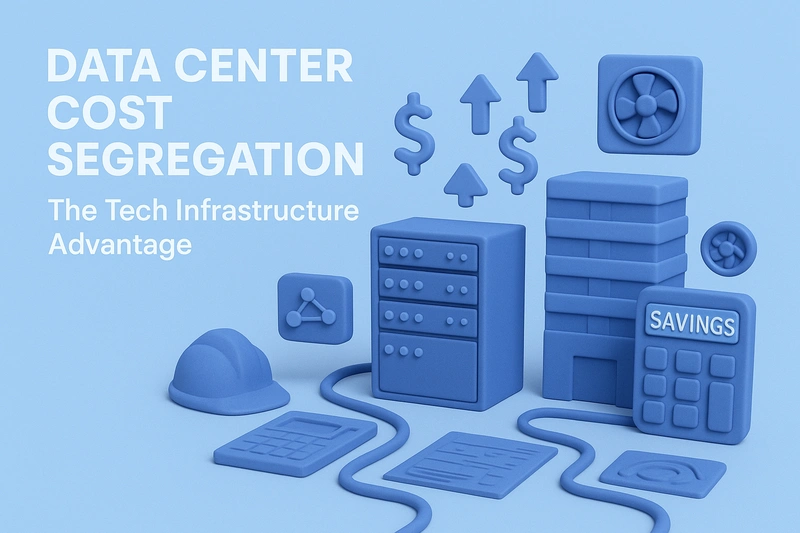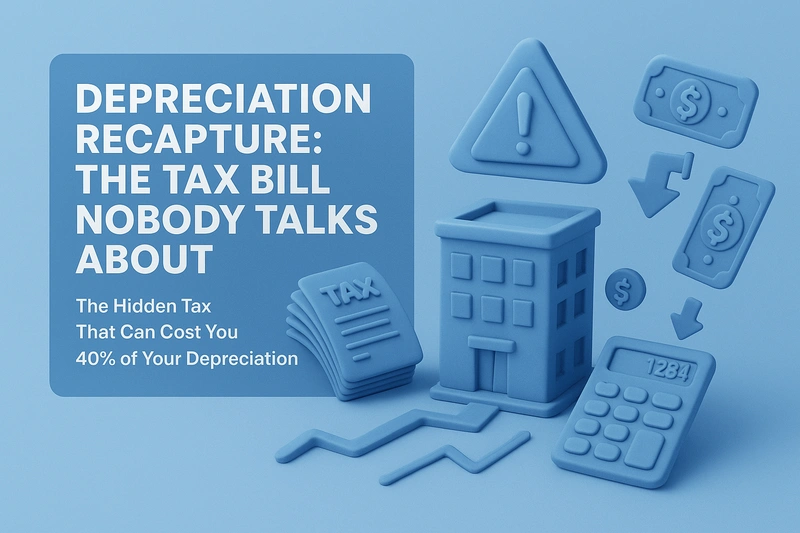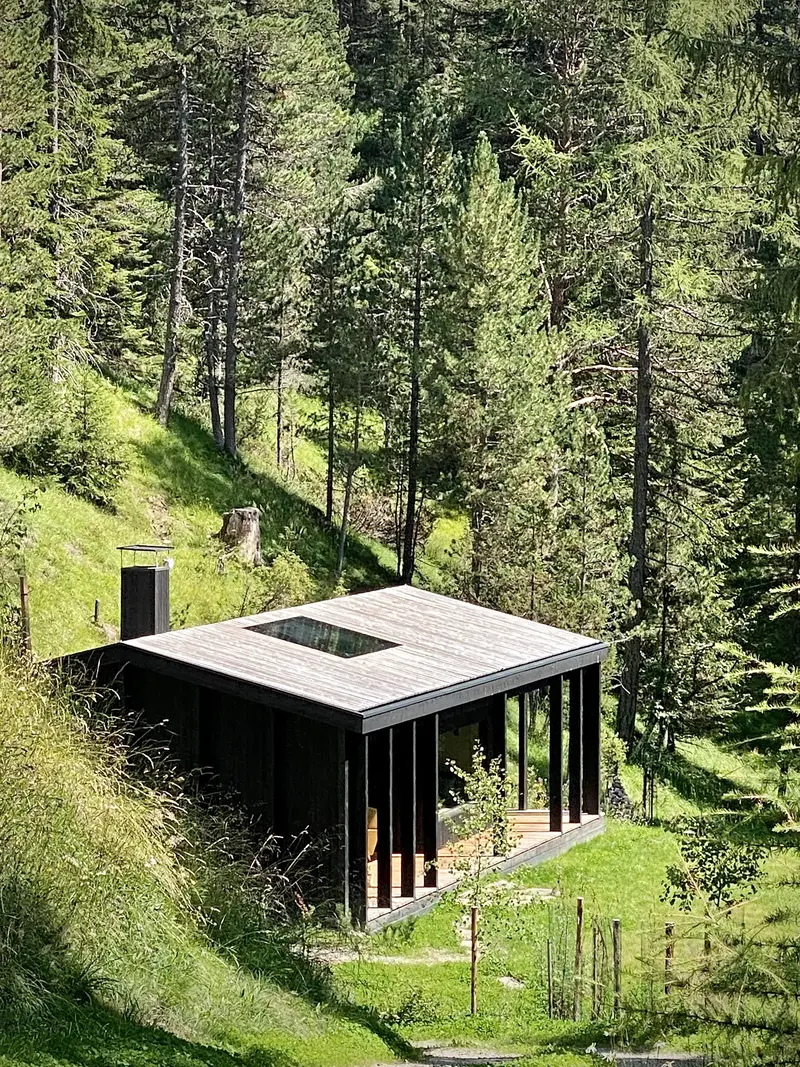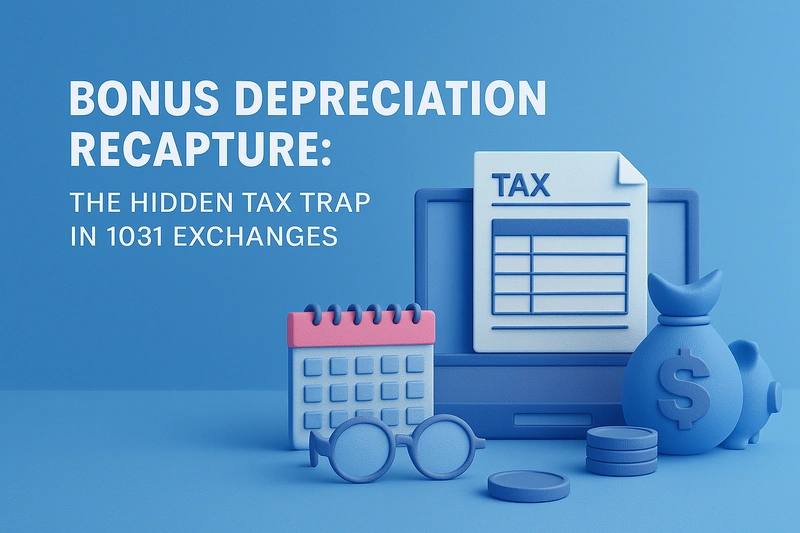Data center owners are leaving millions in tax deductions on the table by not properly classifying their tech infrastructure for depreciation purposes. A recent R.E. Cost Seg analysis of a 75,000-square-foot facility in Northern Virginia revealed $2.5 million in accelerated depreciation opportunities that the owner's CPA had missed entirely.
Data centers contain more specialized technical infrastructure per square foot than almost any other commercial property type. Between 40% and 60% of total construction costs typically qualify for accelerated depreciation through proper cost segregation services. With permanent 100% bonus depreciation, these components now deliver immediate tax savings that transform project economics.
Server facilities present unique depreciation advantages because of their intensive technical systems. Specialized cooling equipment, redundant power infrastructure, and dedicated electrical distribution all qualify for immediate expensing when properly classified.
For a $10 million data center project acquired after January 20, 2025, tech infrastructure depreciation strategies now generate $3.5 million to $6 million in first-year deductions.
What Makes Data Centers Unique for Cost Segregation?
The Technical Infrastructure Goldmine
Data centers pack more depreciable personal property into their footprint than traditional commercial buildings. R.E. Cost Seg studies consistently identify four major categories that now qualify for 100% bonus depreciation.
Server equipment and racks qualify as 5-year property under IRS guidelines. This includes the physical rack infrastructure, cable management systems, and dedicated power distribution units. Under the Big Beautiful Bill Act, these assets receive immediate expensing.
Specialized cooling systems designed specifically for IT equipment also qualify for 100% bonus depreciation. These aren't standard HVAC systems. They're precision cooling units engineered to maintain specific temperature and humidity ranges for sensitive electronics.
Redundant power systems represent another significant opportunity for immediate deduction. UPS infrastructure, battery backup systems, and dedicated electrical distribution for server loads all qualify for 100% bonus depreciation when properly documented. Raised flooring systems, when installed primarily for cable management and cooling distribution, qualify as 15-year property eligible for full immediate expensing.
Can You Combine Cost Segregation with Energy Efficiency Incentives?
Energy-efficient data center components unlock multiple layers of tax benefits. Beyond standard cost segregation, facilities meeting energy efficiency standards qualify for Section 179D deductions up to $5.65 per square foot when prevailing wage requirements are met. These benefits stack with 100% bonus depreciation, creating multiple tax advantages from the same improvements.
High-efficiency cooling systems, LED lighting retrofits, and advanced power management systems qualify for both 179D deductions and accelerated depreciation. Free cooling systems using outside air, liquid cooling solutions for high-density computing, and renewable energy infrastructure all receive favorable treatment.
Water-saving technologies in cooling systems and heat recovery equipment that repurposes server exhaust for building heating also qualify for accelerated treatment. The environmental benefits translate directly to tax advantages, making sustainable design financially compelling.
R.E. Cost Seg coordinates both analyses to maximize total tax savings while maintaining compliance.
How Does Land Value Affect Your Cost Segregation Study?
Land value directly impacts the depreciable basis available for cost segregation. A $10 million purchase price might include $2 million in land value, leaving $8 million for depreciation. In high-value markets like Northern California or Northern Virginia, proper land allocation becomes critical.
R.E. Cost Seg uses comparable sales data and appraisal methodologies to support land valuations. This ensures the maximum depreciable basis remains available for tech infrastructure classification.
How Does the Depreciation Advantage Break Down?
The Big Beautiful Bill Act fundamentally changes the math. Standard commercial buildings depreciate over 39 years using straight-line methods. Data center cost segregation reclassifies significant portions to personal property eligible for 100% bonus depreciation.
Consider a $10 million data center facility purchased after January 20, 2025. Traditional depreciation generates approximately $256,000 in annual deductions. After professional cost segregation services identify technical infrastructure components eligible for 100% bonus depreciation, first-year deductions can exceed $4 million.
The entire qualified amount drops straight to the bottom line in year one, eliminating tax liability while preserving capital for growth.
Which Critical Tech Infrastructure Components Qualify?
Dedicated Electrical Systems for Servers
Data center electrical systems are divided into distinct categories for depreciation purposes. Branch circuits feeding server racks qualify as 5-year property, now eligible for 100% bonus depreciation. These dedicated circuits, including power distribution units (PDUs) and remote power panels, serve specific IT equipment rather than general building operations.
R.E. Cost Seg engineers analyze electrical load calculations to determine precise allocations. A typical data center dedicates 30% to 50% of its total electrical distribution to server equipment. With permanent 100% bonus depreciation, this percentage translates directly to immediate deductions. Each circuit requires individual assessment to establish its primary purpose and corresponding tax treatment.
Power monitoring systems and intelligent PDUs that track server consumption also qualify for immediate expensing. These components directly support IT operations and fall outside standard building infrastructure classifications.
Specialized Cooling Infrastructure
Precision cooling systems maintain the controlled environment that servers require. CRAC units, in-row cooling systems, and hot/cold aisle containment structures all qualify for 100% bonus depreciation as 5-year property. These systems differ fundamentally from comfort cooling designed for human occupancy.
Chilled water systems dedicated to IT equipment receive similar treatment. When cooling infrastructure serves both office and server spaces, cost segregation services allocate costs based on capacity percentages. Documentation from mechanical engineers supports these allocations during IRS review.
Backup Power Systems
Uninterruptible power supplies protect data center operations from power fluctuations and outages. These UPS systems, along with their associated battery banks and automatic transfer switches, qualify for 100% bonus depreciation. Generator systems supporting IT loads receive proportional allocation based on their dedicated capacity.
Consider a 2MW data center with $3 million invested in power infrastructure. Proper classification typically moves $1.8 million to personal property. With 100% bonus depreciation, this entire amount becomes immediately deductible, generating approximately $630,000 in first-year tax savings at current rates.
Redundant systems installed for fault tolerance receive the same favorable treatment as primary systems. This includes parallel UPS configurations, dual power feeds, and N+1 cooling designs standard in enterprise facilities.
How Are Server Facilities and Equipment Classified?
Core Computing Infrastructure
Server racks and cabinets form the backbone of data center operations. These components, along with their integrated cable management systems, qualify as 5-year property eligible for 100% bonus depreciation. Network switches, routers, and storage area networks (SANs) receive identical treatment. Each component supports data processing rather than building operations.
Fiber optic cabling throughout server facilities qualifies for immediate expensing when properly documented. This includes horizontal and vertical cable runs, patch panels, and connection hardware. R.E. Cost Seg studies capture these assets through detailed site visits and construction document review.
Structured cabling systems present significant opportunities often missed in standard tax preparation. A 50,000-square-foot data center typically contains $500,000 to $800,000 in qualifying telecommunications infrastructure. With 100% bonus depreciation, this entire amount becomes immediately deductible.
Security and Monitoring Systems
Biometric access systems protecting server rooms qualify as 5-year property eligible for 100% bonus depreciation. This includes card readers, retinal scanners, and mantrap entries. Security cameras monitoring the IT infrastructure receive similar treatment when their primary purpose involves equipment protection rather than general surveillance.
Environmental monitoring equipment tracks temperature, humidity, and airflow within server spaces. These specialized sensors and their associated software platforms qualify for immediate expensing. Fire suppression systems using clean agents designed specifically for electronics protection also receive 100% bonus depreciation treatment.
Raised Floor Systems
Raised flooring in data centers serves technical rather than architectural purposes. These modular systems provide cable management pathways and optimize airflow for cooling efficiency. When installed primarily for IT infrastructure support, raised floors qualify as 15-year property eligible for 100% bonus depreciation.
Documentation establishing the floor's technical purpose proves critical during IRS examination. Construction specifications, design narratives, and mechanical drawings support proper classification.
Leased Data Centers and Tenant Improvements
Can Tenants Benefit from Cost Segregation?
Tenants making substantial improvements to leased data center space absolutely benefit from cost segregation and the new 100% bonus depreciation rules. Qualified leasehold improvements installed after January 20, 2025, are eligible for immediate expensing. Server infrastructure installed by tenants qualifies for 100% bonus depreciation as a 5-year property.
Colocation facilities present unique opportunities. Both landlords and tenants can claim depreciation on their respective investments. Landlords immediately expense qualifying infrastructure and common systems. Tenants immediately expense cage buildouts, dedicated cooling, and their specific equipment. Clear lease agreements defining ownership prevent double-dipping while maximizing benefits for both parties.
How Industry Trends Affect Your Depreciation Strategy
Emerging Technologies and Their Tax Implications
AI computing infrastructure with specialized GPU clusters qualifies for accelerated depreciation. These high-density computing environments often require liquid cooling systems and enhanced power distribution, all of which qualify as 5-year property.
Hyperconverged infrastructure, combining compute, storage, and networking in a single unit, receives favorable treatment. Software-defined data centers with virtualized infrastructure components qualify based on their underlying hardware classifications.
Immersion cooling systems are gaining popularity for high-performance computing and qualify for immediate expensing. These innovative cooling solutions, along with their specialized tanks and fluid management systems, represent personal property rather than building components.
Do Specialized Facilities Like Crypto Mining Qualify?
Cryptocurrency mining facilities and edge data centers receive treatment similar to traditional data centers under the Big Beautiful Bill Act. These facilities often contain even higher concentrations of personal property eligible for 100% bonus depreciation. A typical crypto mining facility might see 60% to 70% of costs qualify for immediate expensing.
Edge computing facilities embedded in cell towers or retail locations also qualify. Micro data centers supporting IoT applications and distributed computing architectures receive identical treatment. The key determination involves the equipment's primary purpose. If it processes data rather than supporting building operations, it qualifies for 100% bonus depreciation.
How Do Multi-State Operations Affect Your Strategy?
Data center operators with facilities across multiple states face additional complexity. While federal depreciation rules under the Big Beautiful Bill Act apply uniformly, state tax treatments vary significantly. Some states conform to federal bonus depreciation rules. Others require separate depreciation schedules.
California, for example, doesn't conform to federal bonus depreciation, requiring separate tracking for state returns. New York partially conforms with specific limitations. Virginia and Texas generally follow federal rules, simplifying multi-state compliance.
R.E. Cost Seg maintains current knowledge of state-specific requirements, ensuring studies address both federal and state implications. This multi-jurisdictional expertise proves critical for operators with geographically distributed facilities.
How to Maximize Your Data Center Depreciation Strategy
When Should You Time Your Cost Segregation Study?
The Big Beautiful Bill Act creates new timing considerations. Properties purchased after January 19, 2025, receive permanent 100% bonus depreciation. Properties purchased before this date still operate under the previous phase-down schedule (60% for 2024). This creates a potential incentive to time acquisitions strategically.
New construction projects benefit most when cost segregation planning begins during design phases. R.E. Cost Seg engineers identify classification opportunities before construction starts, ensuring proper documentation for 100% bonus depreciation claims.
Existing facilities also present opportunities. Properties placed in service within the past 15 years can file Form 3115 for accounting method changes, capturing missed depreciation without amending prior returns. While these older properties don't qualify for 100% bonus depreciation, the catch-up adjustment still provides significant current-year deductions.
How Does Depreciation Affect Your CapEx Decisions?
The availability of 100% bonus depreciation fundamentally alters capital expenditure planning. Projects previously delayed for budget reasons now generate immediate tax savings that offset cash outlays. A $5 million infrastructure upgrade generates $1.75 million in tax savings at a 35% rate, effectively reducing net cost to $3.25 million.
This dynamic encourages accelerated technology refresh cycles. Equipment previously depreciated over 5 years now delivers immediate benefits, making regular upgrades more financially attractive. Data center operators can maintain cutting-edge infrastructure while optimizing tax positions.
Strategic CapEx timing around year-end becomes critical. Projects completed by December 31 generate deductions for that tax year, potentially eliminating entire tax liabilities.
How Do You Choose the Right Cost Segregation Provider?
Not all cost segregation firms understand data center complexity. R.E. Cost Seg specializes in technical infrastructure unique to these facilities. Our engineers possess specific expertise in data center systems, from power distribution to cooling design.
Experience matters when defending positions during an IRS examination. Quality providers deliver engineering-based studies that withstand scrutiny. Look for firms with dedicated data center experience, professional engineers on staff, and comprehensive audit support.
Beware of template-based studies that miss facility-specific opportunities. Each data center presents unique characteristics requiring customized analysis. R.E. Cost Seg conducts thorough site visits, examining actual installations rather than relying solely on construction documents.
What Documentation Do You Need for a Cost Segregation Study?
Successful data center cost segregation depends on comprehensive documentation. With 100% bonus depreciation at stake, proper records become even more critical. Detailed electrical load calculations prove essential for allocating distribution systems between building and IT operations. Equipment specifications and manufacturer cut sheets establish asset classifications.
As-built drawings highlighting IT infrastructure provide the roadmap for site visits. These documents identify dedicated systems qualifying for immediate expensing. Vendor invoices that segregate equipment costs from installation support precise allocations. Without proper documentation, aggressive positions become difficult to defend during an IRS examination.
What's the Real Financial Impact of Cost Segregation?
Case Study: 50,000 SF Data Center Facility Under New Rules
A recent R.E. Cost Seg study analyzed a $25 million data center project scheduled for purchase in February 2025. Under the Big Beautiful Bill Act's permanent 100% bonus depreciation, the results are transformative.
Cost segregation results broke down as follows. Five-year property totaled $8 million, representing 32% of project costs. Seven-year property reached $2 million (8%). Fifteen-year property accounted for $3 million (12%). All $13 million in personal property qualifies for 100% bonus depreciation, generating immediate deductions rather than spreading over decades.
First-year tax benefits now exceed $13 million in deductions compared to $256,000 under traditional depreciation. Assuming a 35% tax rate, this generates $4.55 million in immediate tax savings. The impact on project ROI and cash flow fundamentally changes investment calculations.
What's the typical ROI on a data center cost segregation study under 100% bonus depreciation?
With permanent 100% bonus depreciation, data center studies deliver unprecedented returns. Study costs of $15,000 to $40,000 now generate millions in first-year tax savings. The ROI often exceeds 100x for qualifying properties.
What Happens If You Sell Your Data Center?
When selling property with accelerated depreciation, investors face recapture rules. Section 1245 property (5 and 7-year assets) recaptures as ordinary income up to the depreciation taken. With 100% bonus depreciation, the entire cost basis taken as an immediate deduction potentially faces recapture.
Planning strategies minimize recapture impact. Like-kind exchanges under Section 1031 defer recapture when exchanging into replacement property with equal or greater value. The Big Beautiful Bill Act makes proper exit planning even more critical, given the larger depreciation amounts at stake. R.E. Cost Seg models recapture scenarios during initial studies, helping investors plan optimal hold periods and exit strategies.
Staying Current with Legislative Changes
The Importance of Monitoring Tax Law Evolution
Tax legislation directly impacts data center economics. The Big Beautiful Bill Act demonstrates how quickly rules change. Smart operators maintain relationships with tax professionals who monitor legislative developments.
Future legislation may enhance or modify current benefits. Proposals for increased energy efficiency incentives, infrastructure investment credits, and technology-specific deductions regularly appear in Congress. R.E. Cost Seg tracks these developments, alerting clients to planning opportunities.
State-level incentives also evolve rapidly. Data center tax abatements, sales tax exemptions on equipment purchases, and utility rate structures vary by jurisdiction. Comprehensive tax planning considers federal, state, and local opportunities.
Unlock Your Data Center's Tax Advantage Today
The Big Beautiful Bill Act fundamentally changes the math. Standard commercial buildings depreciate over 39 years using straight-line methods. Data center cost segregation reclassifies significant portions to personal property eligible for 100% bonus depreciation.
To give you a clear picture, let's dive a bit deeper into the depreciation calculation. To calculate these deductions, data center owners need the cost of the equipment, the date it was put into service, and knowledge of whether they've elected to use Section 179 or bonus depreciation. In the case of technical infrastructure like information systems, which include processors and computers, they typically have a class life of 5 years based on Rev. Proc. 87-56.
Suppose the equipment costs $10,000. For the first year, you would divide the $10,000 by its 5-year life to get $2,000. Then, you would multiply $2,000 by 200% to derive the depreciation for the first full year, $4,000.
However, if you only used the equipment for half the year, your final depreciation expense for the first year would be 50% of $4,000, which is $2,000. This calculates depreciation in the scenario where the mid-year convention is applicable.
Consideration should be given to recalculation if the useful life or basis of the asset changes significantly. Also, the rules vary for short tax years and for assets with an adjusted basis for any reason other than depreciation allowed or allowable - do make sure you're aware of this, and consult with a tax advisor to ensure you are using the correct method effectively.
Technical infrastructure components, from server facilities to specialized cooling systems, now qualify for immediate expensing when properly documented.
Whether you own traditional data centers, colocation facilities, or emerging crypto mining operations, proper classification under the Big Beautiful Bill Act unlocks unprecedented tax advantages. Be proactive, plan, and get professional cost segregation studies for maximum benefit.
Calculate Your Data Center Tax Savings Under 100% Bonus Depreciation
R.E. Cost Seg specializes in maximizing benefits under the Big Beautiful Bill Act. Our engineering team understands both data center systems and the new 100% bonus depreciation rules.
Request your free proposal to discover how the new legislation transforms your property's tax strategy.
Our team of experts will work with you to identify potential savings and make the process easy and hassle-free.






